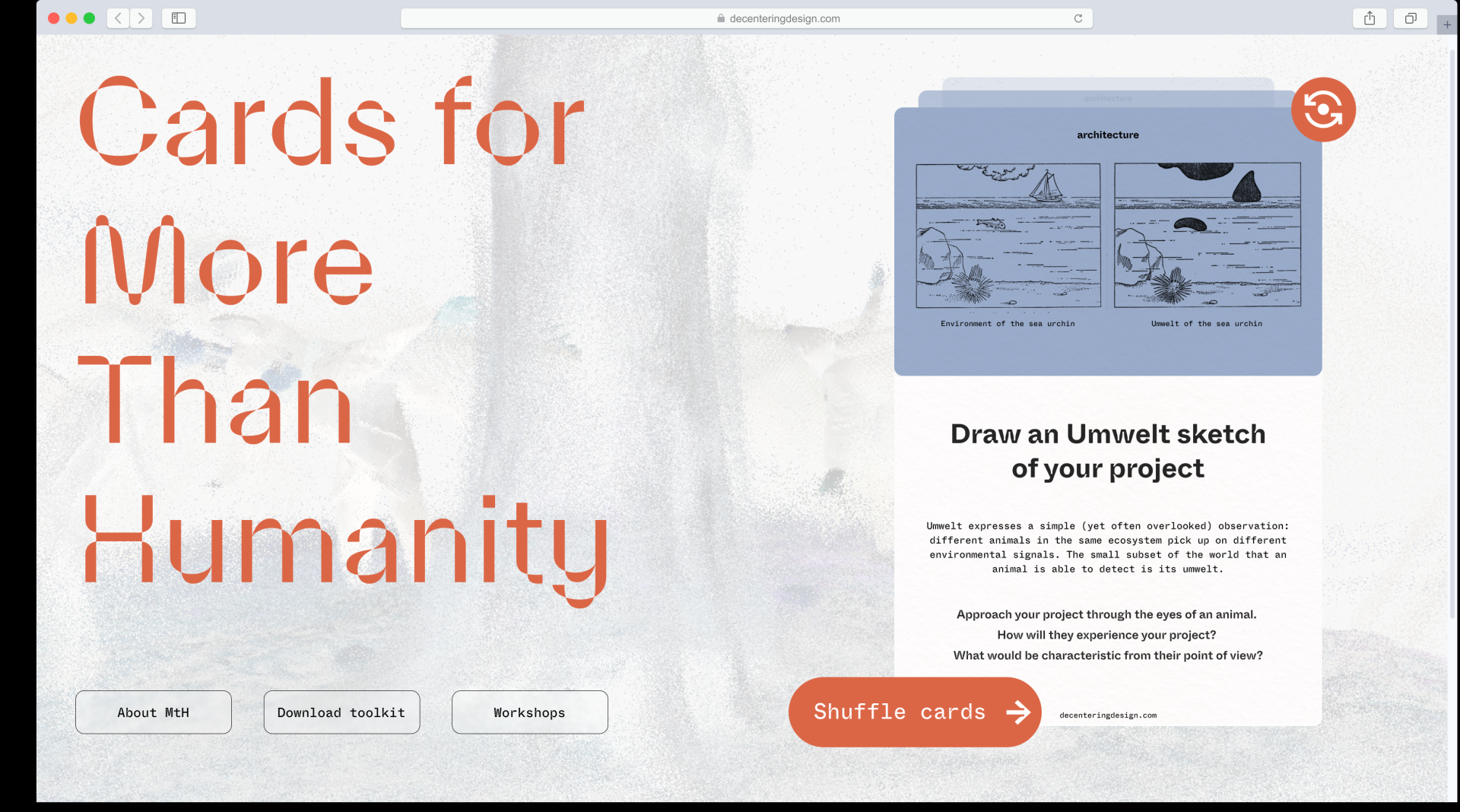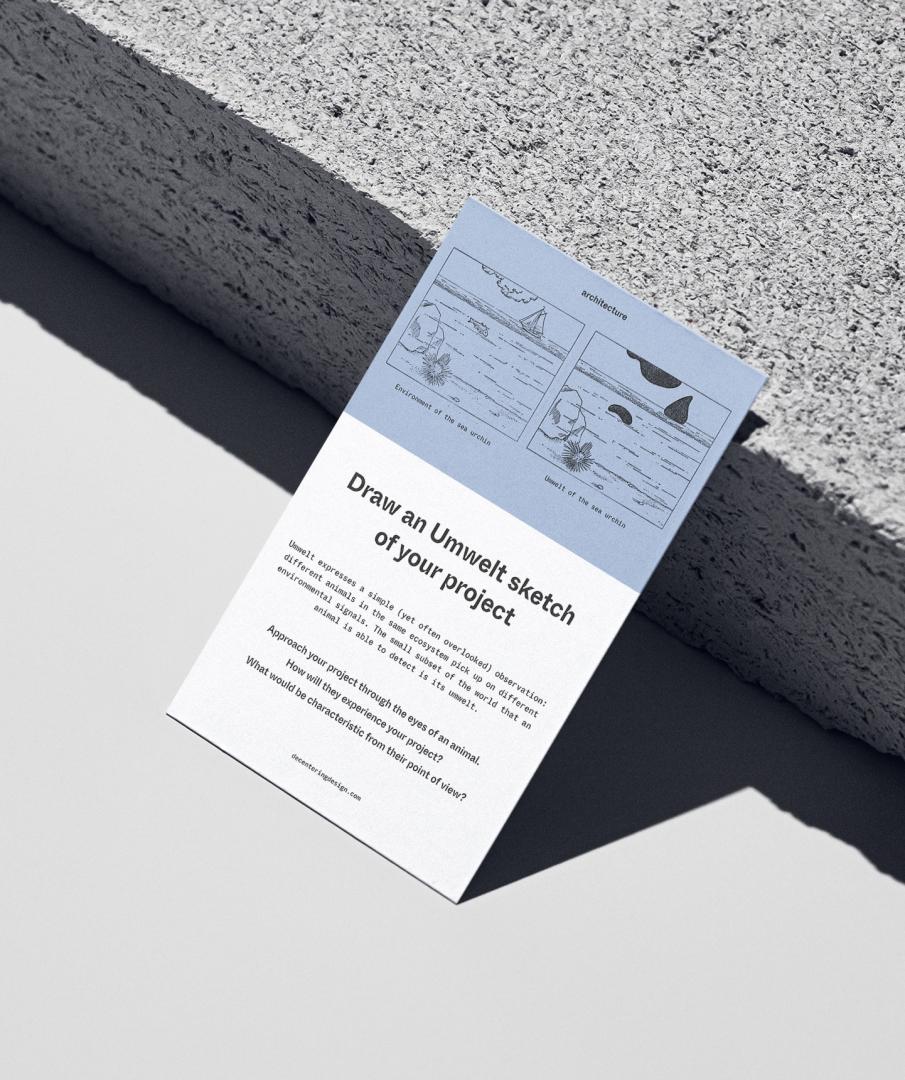Cards for More-Than-Humanity
Basic information
Project Title
Full project title
Category
Project Description
This project takes its cue from the growing realization that humans are not the only ones with agency on this planet. Animals do too. Cards for More-Than-Humanity is an online tool bringing awareness to the more-than-human world in design processes. It generates random scenarios, bringing together human and nonhuman needs and narratives. The designer is confronted with a new perspective to reflect on in relation to their product, bringing all users a step closer to a more inclusive world.
Geographical Scope
Project Region
Urban or rural issues
Physical or other transformations
EU Programme or fund
Which funds
Description of the project
Summary
This project takes its cue from the growing realization that humans are not the only ones with agency on this planet. Animals do too. They develop meaningful relationships with the landscape they inhabit, shaped by their own history, culture and individuality. Just like humans, these meaningful relationships congeal into material reality: animals do not only connect passively with a world ready-made and out there, but actively build and shape their environment. They do so in relation to us and all other creatures, the worlding of the world is always a ‘becoming with’: actions of myriads of creatures continuously give rise to the world.
However, living in the anthropocene means that we are living in a world where most (design) decisions are informed by human needs. It is essential that we start thinking about consciously living toward the post-anthropocene: a world where more-than-human entanglements are permanently and undoubtedly taken into account. This is a challenging task. Can we create a tool which enables humans to design more inclusive futures? One that entangles multispecies narratives?
We have to approach our world as a network, unique in space and time. A constellation of humans and non-humans that shape their surroundings continuously and simultaneously. This means that the design process should be a shared undertaking. Giving non-humans a voice is crucial, as it is easy to dismiss non-human needs as incomprehensible and inconvenient. We are aware that there are limitations of giving a voice to the non-human, however, we do think it is possible to ‘decenter’ the design process.
We propose a tool, taking on the design language of a card game. The cards generate random scenarios, bringing together human and nonhuman needs and narratives. The designer is confronted with a new perspective to reflect on in relation to their product. It is a small step to integrate in their thought process, with vast consequences and benefits for the more-than-human world.
Key objectives for sustainability
We make a move away from the ubiquitous human-centered design approach and decision processes. Our proposal has 3 key objectives that build onto each other. To realize actual change, we need to realize a mindset shift. The design discipline has seen enormous change over the past decades. We have started to understand the importance of actually engaging in conversation with the end user, evidenced by non-design oriented service providers incorporating human-centered design processes. But is that enough? Effects of any human oriented project always extend to the more-than-human world. Therefore it is of vital importance to extend ux-design and research beyond the human as well. The first objective is to create this mindset shift.
Our second objective is to propose a toolkit that leads to more inclusive design by understanding our non-human stakeholders. It stimulates critically questioning design proposals from a non-human perspective and iterating accordingly.
For instance, a designer is confronted by bats’ sensitivity to white LED light. They can now decide to incorporate light with different wavelengths, to not disturb these nightly creatures. Doing this helps to not aggravate biodiversity loss and creates a positive effect for humans, since bats keep the mosquito population balanced.
A stretch key objective is to accomplish a fundamental change in the design process where the non-human is unquestionably part of the conversation. When drawing up a list of stakeholders it should always be understood as a more-than-human network. Ultimately, this sensitivity should lead to understanding how humans and non-humans are entangled and can only live successfully together when products, spaces, landscapes are designed with the ambition to strengthen this connection, positively impacting biodiversity and natural ecosystems. This outlook will undoubtedly affect decisions regarding material use, as well as stimulating regenerative thinking and sustainable design choices.
Key objectives for aesthetics and quality
The answer to this question is twofold. As we propose not a physical end-product but rather a process-related ‘product’ our key objective is to engage with designers who first and foremost are in charge of the aesthetic quality of their output. The toolkit acts as a catalyst between the designer and the non-human, resulting in a positive outcome for all. The designer engaging with our toolkit is the ideal candidate to shape a beautiful inclusive future. In present day ‘requirements’ for a sustainable biodiverse future are often approached as that: requirements that should be checked off, not something that is an added value to the final design proposal. We hope that our toolkit will change this mindset. If the design process is inclusive to its core, it will strengthen the experience of both target groups.
However, as we are designers ourselves, we naturally recognise that our toolkit itself should hold aesthetic quality as well as provide a good user experience. By designing a toolkit that is playful, has a low barrier of entry and provides meaningful discussion, interacting with our target audiences will be much easier. Playful illustrations will highlight the concepts explained on the card. Beautiful set typography will explain these concepts further.
Key objectives for inclusion
The objective of our proposal is to speed up the process of moving into the post-anthropocene. It is universal design by definition: trying to develop a sensitivity towards the needs of all inhabitants (human and more-than-human) of the world around us. Additionally, we acknowledge that the design process is not solely owned by the designer. When designing products, spaces, landscapes, it is essential that the proposed solution is supported by the stakeholders – especially when certain design decisions are informed by non-human actors. It is here that we see great potential for the physical manifestation of our product. Through co-design workshops the designer can engage citizens to contribute to the design process, whilst at the same time educating people on the more-than-human entanglement of their worlds. It is then much easier to understand certain design choices. If one knows the red-coloured street lights create less light pollution for nocturnal animals – and how it benefits humans in turn – people are much more likely to support that idea.
In these co-design workshops the card game should not be presented as a fixed, final product. By providing templates on which workshop participants can contribute other more-than-human actors we allow for modularity and stimulate participation and further inclusion. It also should be noted that the concepts of the card game have been – and will be – further developed through co-design workshops with versatile audiences.
Physical or other transformations
Innovative character
By providing a tool for designers to critically question their proposal from more-than-human perspectives, we create a sensitivity to our entangled worlds, subsequently leading to designs that are more inclusive and tailored to our shared world. By repeating the process over time, the professional world will be stimulated to internalize a sensitivity to the more-than-human world, eventually shaping more inclusive design processes. This in turn can shape designs with multispecies use cases, as well as a greater regard to material use and circularity. When one becomes aware of how important it is to aim for a balanced, more-than-human future, we believe that this will impact every choice in the design process.
Designers often include participatory processes such as co-design workshops to shape new places and products. We also see a role for this toolkit to play a role in those situations: to educate other stakeholders on designing for more-than-humans. Finally, as designers ourselves we take an inclusive approach in the development of the toolkit.
Last but not least, we think that our toolkit enables designers to break existing thought patterns and we hope this also leads to intriguing, aesthetically pleasing solutions where non-human solutions are part of the core of the design. And as designers ourselves we will make sure that our toolkit is beautiful, easy to use and provides meaningful suggestions, allowing us to interact with our target audience much easier.


